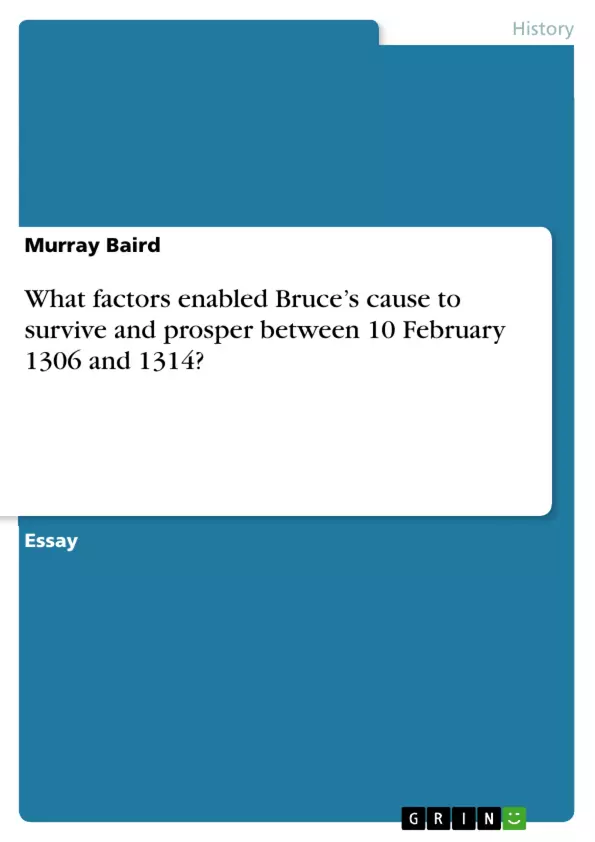The factors which enabled Bruce’s cause to survive and prosper between the murder of John Comyn on 10 February 1306 and 1314 are multifarious and inter-linked. However, these factors all revolve around the separate, converging movements of Bruce seeking support for the seizure of the Scottish throne and of a patriotic cause associated with the community of the realm seeking to overthrow English overlordship claims. These movements merged as one, assisted by Robert I, due to factors including the political polarization of Scotland created by the murder of Comyn within the wider scenario of the Anglo-Scottish war. Bruce’s ability to survive and prosper depended on his political and military acumen in taking advantage of existing political divisions and the enlisting of popular support bolstered by English repression. The death of Edward I and the comparative ineptitude of Edward II were fortuitous factors which gave Bruce time and space to pursue his Scottish opponents to defeat or submission. Similarly, the settlement of the civil war allowed Robert to concentrate on the remaining vestiges of English control in Scotland and take the war into the north of England. By doing so Robert enhanced his kingship through victory. The reinstatement of Scottish kingship as the centrepiece of Scottish independence exuded by the community of the realm, support from a nationalist clergy and the use of propaganda allowed the Bruce cause to prosper, demonstrated further by parliamentary activity and international diplomacy. The final contributory factors, and the ultimate convergence of the Bruce cause with the patriotic cause, emanate from the outcome of the battle of Bannockburn.
Inhaltsverzeichnis (Table of Contents)
- The Murder of Comyn and the Rise of the Bruce Cause
- Bruce's Early Support and the Western Highlands
- The Merging of Bruce's Cause with a Patriotic Cause
- Local Politics and the Anglo-Scottish War
- The Role of Nobles in the Patriotic Cause
Zielsetzung und Themenschwerpunkte (Objectives and Key Themes)
This work explores the factors that enabled Robert Bruce's cause to survive and prosper between 1306 and 1314, leading to the eventual establishment of Scottish independence. The main objective is to analyze the multifaceted and interconnected nature of these factors, encompassing both Bruce's political and military strategies and the burgeoning Scottish nationalist movement. Key themes explored in the text include:- The influence of internal Scottish politics and the murder of John Comyn on Bruce's rise to power.
- The merging of Bruce's personal ambitions with a wider patriotic cause for Scottish independence.
- The role of local political dynamics, particularly in the western highlands, in shaping Bruce's strategy and gaining support.
- The importance of key figures such as James Douglas and the MacDonalds in supporting Bruce and fostering a sense of national unity.
- The significance of propaganda and diplomacy in consolidating Bruce's legitimacy and building a strong Scottish identity.
Zusammenfassung der Kapitel (Chapter Summaries)
The initial chapter delves into the circumstances surrounding John Comyn's murder and the immediate consequences for Bruce's cause. It examines the political landscape of Scotland at the time, highlighting the existing tensions and divisions that were exacerbated by the assassination. The chapter concludes by exploring the early challenges faced by Bruce, including his initial lack of widespread support and the need to secure his position within the kingdom. The second chapter shifts focus to the convergence of Bruce's ambitions with the growing sentiment for Scottish independence. It analyzes the role of the Anglo-Scottish war in furthering this cause, particularly as local political factions sought alliances and support. The chapter highlights the influence of key nobles like James Douglas, whose motivations and actions contributed to the development of a unified patriotic movement.Schlüsselwörter (Keywords)
This study examines the core themes of Scottish independence, political maneuvering, nationalism, internal strife, and the Anglo-Scottish war. It explores key figures such as Robert Bruce, John Comyn, James Douglas, and the MacDonalds. The text also delves into the strategic importance of the western highlands, propaganda, and the evolution of a shared Scottish identity.- Quote paper
- Murray Baird (Author), 2003, What factors enabled Bruce’s cause to survive and prosper between 10 February 1306 and 1314?, Munich, GRIN Verlag, https://www.grin.com/document/203294



